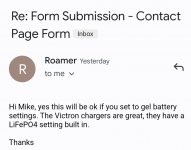It is always tempting to get as much as possible, but it is a very valid point when people say they only use a small portion of the available power, to question if is there a need to have that much in the first place then? Is it like having a Ferrari to go do the shopping?*
I took a different approach and added Lithium (currently got 200Ah installed) but kept my Lead Acid batteries as well (300Ah). I can monitor my useage and generally speaking all the day to day use is from the Lithium, but occasionally the Lead Acid gets dipped into.
What this means is I have 500Ah of Batteries, but only 200Ah of it is expensive Lithium doing something, and the remaining 300Ah is the cheaper Lead (my 3 x 100Ah Lead Carbon batteries were less than one of my 100Ah Lithiums) is there as a backup for those occasions when more energy is needed (maybe a higher demand or maybe
solar charging has been pants for a week?).
Personally I found this approach the ideal balance between capacity and cost, with the main possible downside being weight - you are still carrying around the weight of the Lead Acid batteries and as they are not used much day to day, they could be considered like ballast and impacting your available payload. I don't have a payload issue so it is not a problem for me, but could be for others.
One other aspect of the approach of maybe thinking a single 100Ah Lithium is ok as your demands are low ... If you have, or intend to get an
inverter, depending on the size, the high current demand, even if used for just a minute, could be beyond the capabilty of a single smaller
battery. You might need multiple batteries to counter that? I work on the principle with Lithium of no more than 1000W of
inverter for each 100Ah
Battery (and it has to be a
battery with a decent BMS with a suitable current capability).
* I didn't have a Ferrari, but when I found I was only using my 200BHP Turbocharged 4WD Celica GT4 to go to the shops, it was time to sell and I bought a 1.4L Peugeot 306 instead




